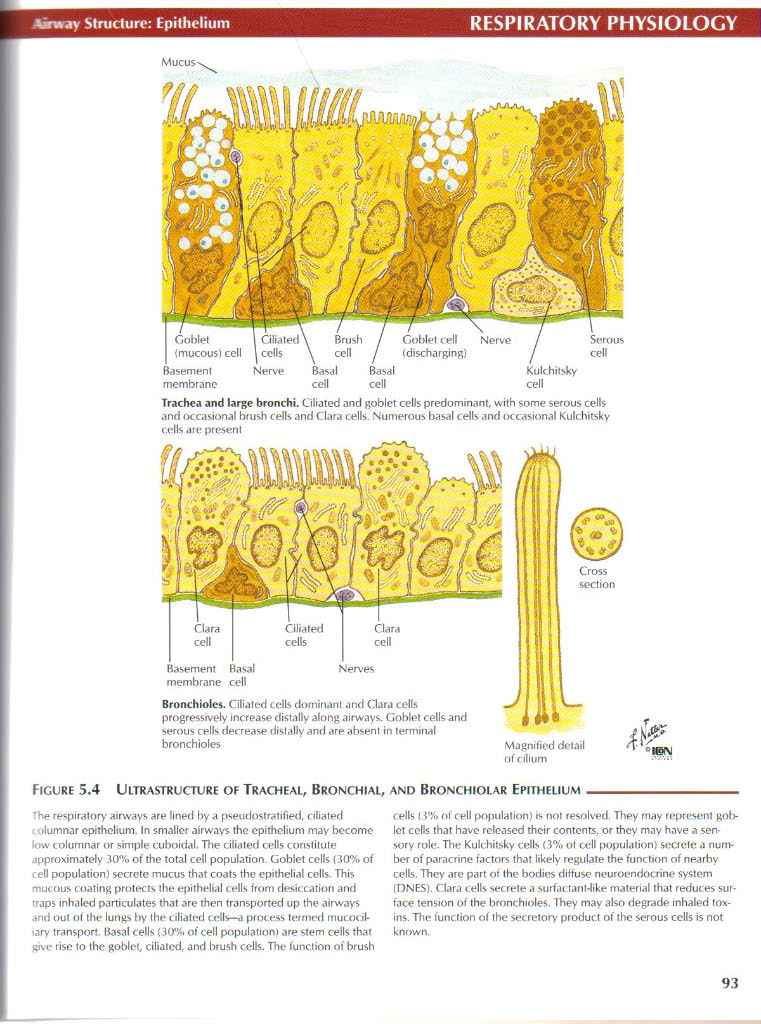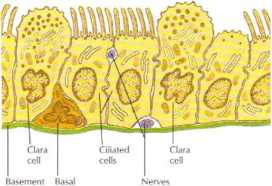netter78

Airway Structure: Epithclium
RESPIRATORY PHYSIOLOGY
Mucus-
Goblet (mucous) celi Basement membrano
1 Gliated \ B 1 cells \ c Nerve Basal celi
Goblet celi (discharging)
Nerve
Kulchitsky
celi
Trachea and large bronchi. Ciliated and goblet cells predommant, wlth some serous cells and occasional brush cells and Clara cells. Numerous basal cells and occasional Kulchitsky cells are present

membranę celi

Magnified detail of cilium
Bronchiolcs. C-ilialed cells dominant and Clara cells progressively increase distally along airways. Goblet cells and serous cells decrease distally and are absenl in terminal bronchioles
UlTRASTRUCTURE OF TRACHEAl, BRONCHIAL, AND BRONCHIOLAR EPITHEUUM
Figurę 5.4
The respiratory airways are lined by a pseudostratified, ciliated ilumnar epithclium. In smaller airways the epithclium may bccome !.»w columnar or simple cuboidal. Tłie ciliated cells conslitute approximately 30% ot the total celi population. Goblet cells (30% of celi population) secrete mucus that coats the epithelial cells. This mucous coating protects the epithelial cells from desiccation and traps inhaled particulates that are then transported up the airways and out ot the lungs by the ciliated cells—a proceSS tefrned mucocil* tary transport. Basal cells (30% of celi population) are stem cells that give rise to the goblet, ciliated, and brush cells. nie func.tion of brush (ells ( 3% of celi jFopulałion) is not resolved. niev may reprrsrnt goł>-let cells that have released thcir contents. or they may have a sensory role. nie Kulchitsky cells (3% ul celi population) sccrctc a num-ber of paracrine factors that likely regulate the function of nearby cells. They are part ot the bodies diftuse neuroendocrine system (DNES). Clara cells secrete a surfac tant-fike materiał that reduces sur-face tension of the bronchioles. They may also degrade inhaled tox-ins. The func.tion of the secretory product of the serous cells is not known.
93
Wyszukiwarka
Podobne podstrony:
11871 netter148 Pancreas Structuri-GASTROINTESTINAL PHYSIOLOGY V / Root of Superio
netter152 Intrahepatii Biliary SystemGASTROINTESTINAL PHYSIOLOGY Noto. The figurę shows bile canalic
netter155 Gallbladder Structure and FunctiunGASTROINTESTINAL PHYSIOLOGY R. and L hepatic duets R. an
netter52 Fxcitation-Conlraclion CouplingMUSCLE PHYSIOLOGY HART 3.1 COMPARISION OF MUSCLE STRUCTURE A
netter76 Airway Struclure: Trachea and Major BronchiRESPIRATORY PHYSIOLOGY Thyroid cartilage -Cricot
30238 netter139 Smali Inlestine Structure: IIGASTROINTESTINAL PHYSIOLOGY Icjunum (high power) Two je
netter142 Large Intestine StruclureGASTROINTESTINAL PHYSIOLOGY Colon: low-power longitudinal Colonie
więcej podobnych podstron